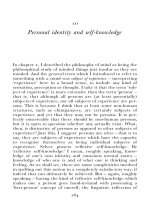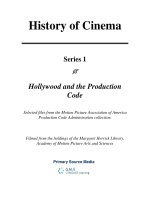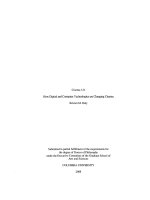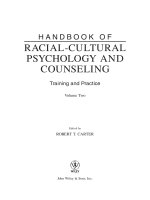Luisa rivi european cinema after 1989 ~ cultural identity and transnational production
Bạn đang xem bản rút gọn của tài liệu. Xem và tải ngay bản đầy đủ của tài liệu tại đây (1.02 MB, 208 trang )
European Cinema after 1989
This page intentionally left blank
European Cinema after 1989
Cultural Identity and
Transnational Production
Luisa Rivi
European Cinema after 1989: Cultural Identity and Transnational Production
Copyright © Luisa Rivi, 2007.
All rights reserved. No part of this book may be used or reproduced in any manner whatsoever without written permission except in the case of brief quotations embodied in critical articles or reviews.
First published in 2007 by
PALGRAVE MACMILLAN™
175 Fifth Avenue, New York, NY 10010 and
Houndmills, Basingstoke, Hampshire, England RG21 6XS.
Companies and representatives throughout the world.
PALGRAVE MACMILLAN is the global academic imprint of the Palgrave Macmillan
division of St. Martin’s Press, LLC and of Palgrave Macmillan Ltd. Macmillan® is a
registered trademark in the United States, United Kingdom and other countries. Palgrave
is a registered trademark in the European Union and other countries.
ISBN-10: 0-230-60024-7
ISBN-13: 978-0-230-60024-9
Library of Congress Cataloging-in-Publication Data
Rivi, Luisa, 1958–
European cinema after 1989: cultural identity and transnational production / by Luisa
Rivi.
p. cm.
Includes bibliographical references.
1. Motion pictures—Europe—History. I. Title.
ISBN 0-230-60024-7
PN1993.5.E8R58 2007
791.43094—dc22
2007013922
A catalogue record of the book is available from the British Library.
Design by Scribe Inc.
First edition: November 2007
10 9 8 7 6 5 4 3 2 1
Printed in the United States of America.
To my father, the first Europeanist, and my mother.
Per mio padre, il primo Europeista, e mia madre.
This page intentionally left blank
CONTENTS
List of Figures
ix
Acknowledgments
xi
Introduction: For an Imperfect Europe
1
I
Europeanism And and Its Discontents
11
1
The Political Discourse around the European Union:
A Supranational Europe
13
2
The Return of the Repressed:
European Cinema and the New Coproductions
39
II
In Search of Unlost Narratives
75
3
Nostalgia as a Weak Utopia for Europe
77
4
Underground and the Balkanization of History
91
III
Odysseys
109
5
Postcolonial Europe
111
6
Toward a Global European Cinema
137
Notes
143
Bibliography
177
Index
189
This page intentionally left blank
LIST
OF
FIGURES
Figure 2.1 No Man’s Land: Ciki and Nino in the trench
69
Figure 2.2 No Man’s Land: Cera on the bounding mine
71
Figure 3.1 Nostalghia: The Russian wife and the Italian translator
80
Figure 3.2 Nostalghia: Domenico on the equestrian statue
of Marcus Aurelius
82
Figure 3.3 Nostalghia: Andrei and the Russian dacha inside
the Italian cathedral
84
Figure 4.1 Underground: Marko, Nataljia, and Blacky at
Jovan’s wedding, underground
96
Figure 4.2 Underground: The island drifting away
104
Figure 5.1 Lamerica: Spiro-Michele and Gino:
The exodus from Albania
117
Figure 5.2 Lamerica: The boat sailing for Italy
121
Figure 5.3 La promesse: Assita and Igor walking to the
railway station
124
Figure 5.4 Code inconnu: The old French Arab, Anne,
and the young French Arab on the metro
127
Figure 5.5 Caché: Majid, the Algerian immigrant,
and Georges, the French intellectual
131
Figure 5.6 Caché: Majid: “I wanted you to be present.”
133
This page intentionally left blank
ACKNOWLEDGMENTS
I AM MOST INDEBTED TO GUIDO FINK, MARSHA KINDER, AND JON N.
Wagner for inspiring me with their passion and intellectual dedication,
thus urging me to undertake a path less traveled.
My heartfelt thanks go to scholars and friends who have supported me
in many different ways: Dajna Annese, Alice M. Bardan, Giuseppe
Codeluppi, Loreta Coleman, Rossana Merli, Jerry D. Mosher, Danielle
Muller, Aine O’Healy, Jennifer Rodes, Margaret Rosenthal, and William
Whittington. Grazie infinite to Rachel Bindman for reading through the
manuscript and for her most incisive comments.
I am deeply grateful to my sisters Lorenza and Lorella for timely providing me with a new laptop, after mine was stolen, thus enabling me to
continue writing, and to my brother Sauro, for his loving impatience in
teaching me how to use it.
Finally, thanks to my students in Los Angeles for pushing me further.
This page intentionally left blank
I
N T R O D U C T I O N
FOR AN IMPERFECT
EUROPE
IN NOVEMBER 1989, THE BERLIN WALL WAS DEMOLISHED BY CROWDS
cheering and drinking toasts to it on both sides; there in ruins was the
symbol of the Cold War bipolarism that had molded Europe, as well as
the entire world, after World War II. In August 1991, an unexpected and
aborted coup in Moscow finally decreed the breakup of the Soviet Union
and the failure of the Communist experiment, which had survived as one
of the two great totalitarianisms of the twentieth century. These events
were followed by a series of other upheavals that paved the way for the
reappearance of old nationalisms, as well as for the emergence of new
nation-states in Central and Eastern Europe, and that also provoked the
resurgence of destabilizing separatist movements in Western Europe. The
post–Cold War era thus began by plunging Europe into a state of chaos
and, for many, outright decline. A broader but less visible disturbance
accounts for a Europe “on the verge of a nervous breakdown:” the phenomenon of globalization, which further eroded borders through the
explosion of multinational economic corporations, borderless telecommunication systems, an unparalleled international division of labor, and
global mobility. These factors all occurred within a short time frame,
with the destruction of the Berlin Wall representing an encompassing
historical marker and signifier par excellence.
The diversified transformations on the historical, economic, and sociocultural levels have produced, and continue to produce, constant,
almost daily “visions and revisions” that render the task of talking about
Europe exceedingly problematic, relative, and provisional at best.
Nevertheless, or rather because of such uncertainty, it is important to
understand how Europe is redefining itself as territory, political entity,
2
European Cinema after 1989
and founding myth of Western thinking. One must ask precisely which
Europe is being conjured up in the often-apocalyptic overtones of its
alleged ending: Is it the geographical entity in an ongoing state of deterritorialization and reterritorialization? Or is it the overdetermined and
essentialized idea of Europe, that mythical site of civilization, which no
longer corresponds to its imagined legacy? These perceptions are superimposed onto each other, and contemporary “Europe” evokes both
meanings, becoming a highly contested signifier.
Cinema is a privileged site of this interrogation, as it engages on the
one hand with the politics of cultural production and thus offers the possibility to map a new Europe through industry practices, media regulations, and specific film policies; on the other hand, it uniquely provides
images for a changed European imaginary. Specifically, recent cinematographic coproductions envision and present new ways to rethink Europe
in its geopolitical and symbolic configuration. European Cinema after
1989: Cultural Identity and Transnational Production seeks to investigate
the role and status of cinema as institution and industry in designing a
post–Cold War Europe. The question it wants to address is this: How do
the new coproductions construe post-1989 Europe and European cinema as possible sites of identification and recognition for old and new
Europeans?
The first area of inquiry concerns the phenomenon of supranationalism vis-à-vis cinematographic coproductions after 1989. The lamented
fragmentation of Europe stands as a parallel and opposing discourse of
the post–Cold War era; it is one that aims for integration and recentering
through the constitution of “one common European home,” as Mikhail
Gorbachev expressed it with keen foresight in 1986. Many events, like
the creation of the Single European Market in the same year, the signing
of the Maastricht Treaty in 1992, the circulation of the new common
currency—the Euro—in eleven countries in January 2002, and the
enlargement from its original six member states to twenty-seven in 2007,
mark a new centripetal tendency: the progressive affirmation of Europe
as a political entity, one in the likeness of an “imagined political community,” as Benedict Anderson would have it.1 The fact is that it is not a
nation but an expanding cluster of nation-states that are coming together
into a supranational Europe in the attempt to bestow a pan-European
identity on highly differentiated and multilinguistic nations.
Through its economic and legal provisions, as well as its transnational
organs, the European Union (EU) has created a supranational structure
For an Imperfect Europe
3
that is able simultaneously to accommodate and maintain the opposing
phenomena of localism, micro- and macro-regionalism, and the new
nation-states that are puncturing the revised post-1989 map of Europe.
These supranational enterprises mark a shift from the bipolar configuration established after World War II to a polycentric one, where multiple
powers at the local, national, and global levels coexist within, as well as
create, a supranational framework. Such a change seems to support the
notion that the nation-state, considered to be a specifically European
product, has become obsolete. Recently it has become fashionable to discuss Europe in postnational terms, with traditional boundaries being
blurred and deemed to become unrecognizable, but this misses the larger
point. It is precisely the persistence of the nation-state, with its form of
political associations and communal belonging that will provide a unique
opportunity to shape and sustain such a supranational enterprise. Yet for
this to happen, the conventional meaning of the nation-state must be
rearticulated in different ways. The rearticulation must proceed along the
paths of heterogeneity and the idea of overlapping communities that can
ultimately account for a supranational reconfiguration of post–Cold War
Europe that is neither dualistic nor postnational.2 Only the preservation
cum transformation of the distinctive nation-states through the recognition of other nations may enable a restructuring of Europe that can be
both inclusive and cognizant of its plural and multiple identities.
The peculiar mixture of heterogeneous political configurations and
overlapping spheres of belonging is epitomized by the new cinematographic coproductions. Such films combine the more political tendencies
of this trend with the more recent needs of corporate capitalism, global
distribution, and consumption. As an amalgam of different sources, such
as television, private and independent financing, and state interventionism, cinematic coproductions between different European countries
bring into question the principles and contradictions at work in the project of a supranational Europe. As such, they allow investigating and illuminating the reshaping of a European cultural identity.
Coproduction agreements are certainly not new: The first bilateral
treaties between Italy and France date back to 1946. They reached their
peak in the 1960s, at the time of the economic boom, and declined by
the 1970s because of a drop in attendance and changing viewing habits,
only to be revived and reshaped primarily as broadcasting organizations
during the 1980s. This was chiefly the result of technological advances,
as well as revolutionary efforts to deregulate the audiovisual media.
4
European Cinema after 1989
However, there has been a profound shift in orientation. Although such
forms of cooperation were and still are first and foremost motivated by
economic concerns, the new coproduction agreements foreground a previously nonexistent cultural dimension.3 As much as they are realizations
of multinational late capitalism, the new treaties and the new so-called
“co-financial agreements”—limited to merely financial collaboration—
are nevertheless in alignment with the objectives of a supranational
Europe. Consonant with this notion, the specifically created European
Convention on Cinematographic Co-Production, established by the
Council of Europe in 1992, was designed to “safeguard and promote the
ideals and principles which form [a] common heritage” while being “an
instrument of creation and expression of cultural diversity.” It is precisely
this joint goal—to shape a common European identity while acknowledging old and new configurations—that makes the cinematographic
coproductions of the 1990s the most fertile terrain for redefining
European identity. The issue is a particularly thorny one, given the
almost unanimous dismissal of coproduction agreements as a threat to
the existence of national cinemas. The discourse around coproduced
films in a post–Cold War Europe articulates the dilemma that lies at the
core of the new Europeanism: the tension between a supranational
framework and the individual national identities that underlies the project of a different Europeanness.
No medium is better suited than cinema to engage in the discussion
of the construction and dissemination of national identity. Since its
inception, cinema has constituted a privileged site at which to construct
and transmit the idea of nationhood, not only for a domestic audience,
but for an international one as well.4 A case in point would be the neorealist movement in Italy after World Word II. The film Paisà (Paisan,
Roberto Rossellini, 1946) attempted to forge an identity for postwar
Italy, by coalescing a nation, an “imagined community” around recent
constitutive elements—that is, around new myths, like the suffering of
the common people under the Fascist regime, the role of the Resistance,
and the sacrifice of Italians and Allies alike. It did not matter that only
about 10 percent of the films produced in Italy at the time were neorealist and they were not very popular; those “happy few” managed to establish the image of a new Italy abroad. This is aptly demonstrated by
Sciuscià (Shoeshine, Vittorio De Sica, 1946), which won a special
Academy Award in 1947, and by Ladri di biciclette (Bicycle Thieves) also
by De Sica, which received the first Best Foreign Language Film Oscar in
For an Imperfect Europe
5
1948. Eventually it was the handful of neorealist movies that would garner international legitimization for Italy despite the Italian government’s
initial refusal to identify with those images. Indeed, the ultimate irony
was that the very same films that were supposedly “slandering Italy
abroad”5 were instead able to rehabilitate the nation and give it a new
identity. Furthermore, the fact that Italians of the postwar era would
rather watch the melodramas of Raffaello Matarazzo and the highly successful series of Don Camillo movies only reveals what was at stake in the
neorealist project, namely, the forging of a new nation and ultimately
reinforcing the power of the cinema. What Lenin had defined as “the
most powerful art” could produce images of a unified national identity,
as the neorealist films did, while simultaneously discrediting it by producing other images, other identities—the ones in the melodramas and
the B-films of Don Camillo—that undermined the selfsame idea of the
nation and as such were not recognized by the domestic official culture
or considered internationally viable.6
Because of such national and international interface in the constitution of identities, nations, and diasporic communities, the films discussed here have either been entries or have earned awards in
international festivals; the transnational visibility and the official legitimacy granted by critics and awards are loci for forging different perceptions and different imaginings of Europe. The analyses of specific films
will help concretize the historical, conceptual, and philosophical ideas
that inform a supranational Europe. These films present a mutated post1989 reality and the new cultural identities that are emerging; as such
they help change received notions of a uniform or homogeneous national
identity.
The words of the great Irish poet William Butler Yeats perhaps best
capture the perception of a crumbling Europe after 1989: “Things fall
apart: the center cannot hold.” They evoke the myth of Europe as center,
and the correlated specter of Eurocentrism, as that phenomenon that
claims European values as universal. In 1979, Jean François Lyotard
referred to this phenomenon as a belief in the grands récits, or the master
narratives of Western culture, namely, notions of scientific knowledge,
progress, history, nation-state, liberation, God, truth, and humanism.7
The most compelling films made in Europe after 1989 engage with such
concepts and provide a challenging arena in which to discuss what can be
considered the legacy and the conceptualization of the West from Plato
through the Enlightenment. In a more speculative vein, Lyotard has
6
European Cinema after 1989
acknowledged the profound crisis of the metanarratives. In concrete historical terms, the dismantling of the Soviet Union, the demise of the
Cold War, the reemergence of nationalisms in both the West and the
East, savage corporate capitalism, the ascent of technology, and globalization and its perceived terrors have all combined to slowly erode those
old and reassuring beliefs and narratives, although they had begun to be
questioned even after World War I. Lyotard admits to the disappearance
of the master narratives in a universe that no longer functions according
to totalizing and unitary criteria. In European Cinema after 1989, I argue
that such narratives have in fact not been abandoned but are still present
and operative. However, they need to be reformulated to reflect a new
heterogeneous reality. In fact, such ideals continue to inform not only the
project of an encompassing Europeanness but also the making of old and
new nation-states in Central and Eastern Europe and the former Soviet
Republics, as well as the inclusion of unprecedented flows of migrants
from both the ex-European colonies and the ex-Communist empire.
They operate differently, though, not as universal and unitary concepts
aimed at repressing differences and realizing a uniform social order but as
working principles that acknowledge other ways, other cultures, other
histories, and other languages. The multiple subjects and nations that
contemporary European movies envision challenge a monolithic configuration of Europe and attempt to reconfigure it into a heterogeneous,
hybrid, and polycentric space so as to take into account multiple subjectivities, nations, and realities.
The Italian philosopher Gianni Vattimo offers a highly productive
theoretical framework for understanding the crisis of European myths
and their different repositioning in post-1989 Europe and European cinema. He claims that the current historical moment represents “the end of
modernity,”8 by which he refers to the accomplishment, but not the decadence, of the modern beliefs in reason, progress, history, logic, and the
like. Such ideals have been realized and fulfilled, but they have not disappeared. In this vein, he stands very much against other thinkers like
Jean Baudrillard, who does away with the past in his seductive theorization of the simulacra, and Fredric Jameson, who proclaims the demise of
modernity only to reveal how much he is still wrapped in a “nostalgic
Hegelianism,” in the words of Edward Said.9 Instead, Vattimo formulates
the idea of “weak thought” and the concurrent “ontology of decline” to
refer to the exhaustion cum redirection—not the vanishing—of the project
For an Imperfect Europe
7
of modernity. In this way, he is able to retain the legacy of the past, the
myths of Western Enlightenment, but in a “declined” way, a weakened
and softened form, where “weakening” is not to be perceived negatively—as it is often ordinarily used—but rather represents a valuable
opportunity, the opportunity to think differently, because it opens up a
field of possibilities. Europe can thus be reconfigured in a different way,
a way that still allows for the presence of its grand narratives. Yet they
need to be inflected and accented by the presence of other cultures, other
participants, and different modalities. Ultimately, the Europe facing the
dissolution of its myths is reconstituting itself by transforming and
“weakening” those very myths according to its changed reality or realities;
at the same time, a mutated reality and its multiple subjects have undertaken transformation and redefinition of the cultural identity of Europe.
In this vein, the epistemological grid offered by Vattimo allows for a
profound critique of Western essentialism predicated on the form of
dualistic thinking that has produced the construct of Eurocentrism. In a
most convincing analysis of the phenomenon, Edward Said has unflinchingly demonstrated how this mode of European thinking produced the
obverse construct of Orientalism so as to empower and legitimize the
Occident, namely, Europe.10 The fact is that the notion of Eurocentrism
has been taken to be coterminous with Europe, thereby reducing everything European first to a supposed affirmation of “superiority” and later
reducing it to its demonization as source of all evil. In Unthinking
Eurocentrism, Ella Shohat and Robert Stam seem to be aware of the conflation of European with Eurocentric. They even uncover a form of
inverted Eurocentricism; by making Europe the culprit of all social evils,
they remark how Europe, instead of losing its supremacy, is always positioned as the active subject and ultimately the structuring pole.11 The collision of European and Eurocentric precisely raises the question: Is it
possible to be European without being Eurocentric? Or, put slightly differently, How can Europe be redefined outside of a Eurocentric perspective so that a de-eurocentrized Europe can finally become European, that
is to say, no longer the structuring pole, but one structure among many?
The films that I have chosen point in this direction, toward envisioning
what I would deem an imperfect Europe. The term here has to be understood in light of the dual meaning of imperfect: neither having achieved
a faultless status nor having been completed. If the status of post-1989
Europe is imperfect in the sense that the European project of integration
8
European Cinema after 1989
is incomplete, it is important that that project should be and stay imperfect, so as never to achieve the repressing and totalizing “perfection” that
turned Europe into “the cradle of civilization.”
On the road to imperfection, a new Europe must face its legacy of
having been “the cradle of colonialism,” as it finds itself today in a postcolonial angst precisely because of that past. Postcoloniality must be construed as both the historical marker of the end of colonialism and a
methodology aimed at deconstructing the universalizing Eurocentric discourse of colonialism by tracing the effects and consequences of colonization and denouncing the persistence of colonial practices—this time
repositioned on different economic and cultural grounds, but still yielding a neocolonial stance. A postcolonial discourse would eventually allow
new voices to speak, and it is in this sense that I have identified films that
conjure up a postcolonial Europe, a Europe that is able to acknowledge
many voices instead of imposing its one and only.
Contemporary European cinema engages with the legacy of colonization at its site of origin. It specifically addresses migrants, refugees, asylum seekers, diasporic communities, and extracomunitari (those outside
the EU) who move in the opposite direction, from the peripheries to the
metropole, toward an encounter that the ex-colonizer fears and feels as a
reversed invasion. Many coproduced films deal with the effects of traditional colonialism, as well as with that particular form of colonization
represented by Communist rule, to which Central and Eastern Europe
and the ex-Soviet republics had been subjected until 1989. These films
unravel the contradictions that are paving the way for Europe to become
truly “European” and no longer Eurocentric. They evoke relationships
where the one-to-one colonial positioning has shifted into a hybridity
that may harbor different standings and thus challenge assumed notions
of cultural identity. Coproductions are hybrids that respond to the new
European policies to promote and reflect a “cultural diversity” by bringing into question patterns of duality and antagonism and refashioning
them into more nuanced and ambivalent composites.
The book is organized around a few basic issues that address how cinema is redefining Europe in the post–Cold War era: supranationalism,
cinematographic coproductions, the persistence—although altered—of
grand narratives, and the emergence of a postcolonial Europe.
In Part I, Chapter 1, “The Political Discourse around the European
Union: a Supranational Europe,” explores the new politico-economic
For an Imperfect Europe
9
cartography of Europe and grounds the idea of Europeanism, which will
be later articulated by the cinema of this period. The demise of the Soviet
empire, the onset of globalization, and the completion of decolonization
on the part of the Western empires are responsible for the revival of the
European movement around the historical and symbolic date of 1989. A
new supranational Europe emerges from the Maastricht Treaty of 1992,
which maintains but transforms the Europeanism that first created the
European Economic Community (otherwise known as the Common
Market) by means of the Treaty of Rome in 1957. I specifically argue for
a supranational reconfiguration of Europe to be grounded on the permanence of the nation-state. I assert the validity of the construct while I also
point out the changes that are responsible for a different employment of
the concept in the context of an enlarged Europe.
Chapter 2, “The Return of the Repressed: European Cinema and the
New Cinematographic Coproductions,” takes issue with those elements
through which a “new” Europe is being construed and rendered visible:
recent cultural policies, and specifically, cinematographic coproductions.
While the old treaties never addressed the issue, “culture” has instead
become the catalyst in mobilizing a new Europe. David Harvey, along
with many others, has observed that in the current multinational universe of late capitalism—to which Europe belongs—culture functions as
merchandise; it singles out consumers and then proceeds to market itself
as a commodity in a spiraling market.12 But culture exceeds this function:
if the new coproductions spring unquestionably from a financial necessity, they also work to articulate and express needs of a different symbolic
nature. Contemporary coproduced films portray and articulate a supranational Europe that responds to these needs. I will discuss, in particular,
two highly significant films, Land and Freedom (Ken Loach, 1995) and
No Man’s Land (Danis Tanovi´c, 2001), because they both foreground and
contest a new supranational imaginary for Europe.
Part II, In Search of Unlost Narratives, bears on textual analyses of two
specific films that address recent mutations and therefore render a new
reconfiguration of Europe very concrete. Chapter 3 presents a reading of
Nostalghia (1983) that shows how Andrei Tarkovsky both works within
the grand narrative of dialectics and transgresses it. He does not abandon
but reworks this foundational myth of modern Western thinking on the
grounds that it enables him to conjecture a synthesis of different nature,
a “weakened” synthesis in the terms employed by the philosopher Gianni
10
European Cinema after 1989
Vattimo. The Russian director advances this hypothesis as the means by
which to reconfigure a new Europe in the specific historical circumstances offered by the demise of the Soviet Union.
In Chapter 4, I take issue with what is considered the European myth
of legitimization par excellence: history. History is said to have failed and
thus should be discarded in our present condition of postmodernity.
Emir Kusturica’s Bila jednom jedna zemlja (Underground, 1995) is a
response to this indictment, because the film enacts the breakup of
Yugoslavia in all its implications. The film engages with the historical referent and foregrounds the persistence of history while it subjects the
process of historical construction to a devastating and illuminating critique. Underground raises the issue of the very nature of historical production and compels us to reassess history instead of dismissing it on the
grounds of its “balkanized” form.
In Part III, Odysseys, I posit Europe as being in a postcolonial condition and examine diversified constructs of this configuration by resorting
to the Western trope of the odyssey as the myth that had legitimized voyages of discovery and conquest for Western modernity. That myth has
now been appropriated and reversed by the new migrants who travel to
Europe to both offer their labor and transform the previous empires.
Europe, the literal and figurative incarnation of colonialism, has actually
turned into a postcolonial space where new immigrants, old migrants,
and “Europeans” confront each other and need to shift their no-longer
stable positions. Analyses of Lamerica (1994) by Gianni Amelio, La
promesse (1996) by Luc and Jean-Pierre Dardenne, and Code inconnu
(2003) and Caché (2005) by Michael Haneke allow exploration of different colonial positionings and point to a hybrid and decentralized
makeup of contemporary Europe.
P
A R T
I
EUROPEANISM AND
ITS DISCONTENTS
This page intentionally left blank









